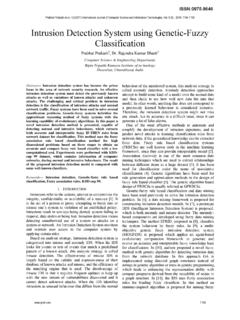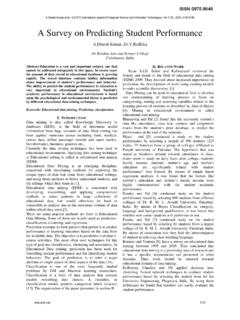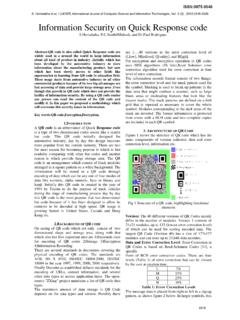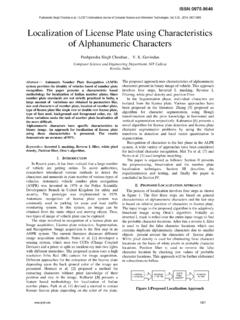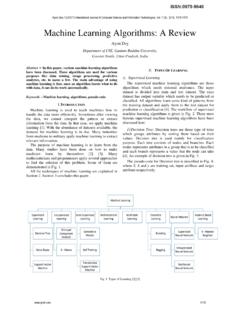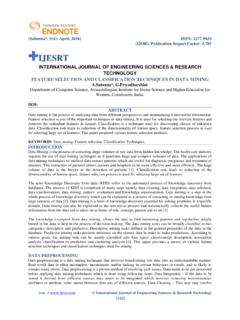Transcription of New technique for Web page Information Categorization ...
1 New technique for Web page Information Categorization using unsupervised clustering Neeraj Mehta, Avinash Rathore IES-IPS Academy,Indore Abstract : Classification of web content is dissimilar in a number of characteristic as compared with web page classification. The unrestrained nature of web content nearby added challenge to web page classification as compared to traditional text classification. The web content is semistructured and encloses arrange Information in form of HTML tags. A web page consists of hyperlinks to position to other pages . This consistent environment of web pages provide features that can be of superior facilitate in classification. primary all HTML tags are removed from the web pages , together with punctuation marks. The subsequently step is to remove stop words as they are frequent to every documents and does not give a lot in searching.
2 In nearly all cases a Firefly Web Page Classification is functional to diminish words to their basic stem. One such frequently used stemmer is the Firefly Web Page Classification. We proposed Web page Information Categorization (WPIC) algorithm can similarly attain the Categorization of Information for dissimilar content .Merge WPIC with personalized search engine technology, and improving the efficiency of WPIC. Keywords: WPIC , URL, text classification, Firefly Web Page Classification. I. INTRODUCTION Currently, the web pages are increasing at an exponential rate and can cover nearly any Information desirable. though, the huge amount of web pages construct it further and more complicated to successfully discover the goal Information for a user. usually two solution subsist, hierarchical browsing and keyword searching.
3 Though, these pages be different to a enormous extent in both the Information content and quality. Furthermore, the association of these pages does not agree to for simple search. So an resourceful and precise technique for classifying this huge quantity of data is extremely necessary if the web pages is to be exploited to its occupied potential. This has been felt for a long time and numerous technique have been tried to resolve this problem. various dissimilar Machine learning based algorithms have been functional to the webpage Information classification task, including k-Nearest Neighbour (k-NN Algorithm) [2], , Neural Networks [3], and decision trees [4] Bayesian algorithm [5], Support Vector Machine (SVM) [6].identify the end user objective in Classical technique web of web page document classification are not suitable for web document classification.
4 Lots of of documents on the Web are to small or suffer from a require of linguistic data. This work treat with this problem in two novel technique experiment have prove that hypertext links in web documents frequently direct to documents with comparable semantic content. This study leads to use these referenced web pages as an extension of the investigated one for the purpose of processing their linguistic data as well. though there are a number of restrictions. The referenced documents have to be placed on the same server and a level of recursion must be limited. The previous technique increases quantity of linguistic data for the nearly all part of documents sufficient but there is another problem. To use machine learning Algorithms we require to construct a high dimensional vector space where every dimension represent one word from or phrase.
5 In spite of the Information that several machine learning algorithms are familiar to elevated number of dimensions, in this case the high number of dimensions decrease algorithm accuracy and Informational - The objective of the user is to get together a number of Information from one or added web pages . Transactional - The intent is to achieve some web- mediate activity, like downloading les, purchase Items online, etc. base on the additional than taxonomy, primary proposed an automatic query goal classification scheme to distinguish merely amongst navigational and informational queries. in classifying queries among navigational and informational classes by allowing for click distribution and anchor link distribution for automatic query classification. Automatic Web page Categorization significant functions in Internet Information and Categorization exploration.
6 This work we will discover out the three subsequent works. The primary the design and implementation of algorithm- Web page Information Categorization (WPIC). Training and classification are two critical stages of WPIC. The subsequent is the application of WPIC in an E-government private organization system. The research to improve the accuracy rate of WPIC and extend the application of WPIC in Information systems more than E-governments, such as E-commerce systems. Somewhat improve the algorithm can equally attain the Categorization of Information for dissimilar content .Merge WPIC with personalized search engine technology, and improving the efficiency of WPIC. WORKEda Baykan in at al[1]compared the performances of the dissimilar URL-based language classifiers along a variety of dimensions such as features, algorithms, and training size.
7 As well tested our greatest performing classifiers on ODP + SER dataset on the classification of multimedia Web pages and in small-scale language-focused crawlers. Summarize our major consequences for URL-based Web page language classification. ISSN: 0975-9646 Neeraj Mehta et al, / (IJCSIT) International Journal of Computer Science and Information Technologies, Vol. 7 (2) , 2016, S. Patil in at al[2] This paper illustrate Na ve Bayesian (NB) technique for the automatic classification of web sites base on content of home pages . The NB technique , is one of the nearly all effective and straightforward techniques for text document classification and has exhibit superior consequences in preceding study conduct for data mining. Ariyam Das in at al[3] classified user purpose into three classes with superior precision based on the narration of how users respond to prior search consequences.
8 As the consequence illustrate, majority of the queries issue to a search engine have a conventional unambiguous goal which can be recognized to a great extent by our classified. Many researcher proposed different technique near a multi-cost-sensitive learning for visual quality Categorization and a multi-value regression for visual excellence score obligation. Our experiment evaluate the extract features and terminate that the Web page s explain visual features (LV) and text visual features (TV) are the most important disturbing factors toward Web page s visual excellence. Supervised and unsupervised learning to categorize queries as informational, not informational, or ambiguous. the majority of these technique have not measured every classes jointly to recognize the user goal in web queries. primary measured all the three classes but did not look clear of the query and url for the classification purpose.
9 We construct ahead the final work based on the perception that the consumer goal for a specified query may be educated from how users in the past have interact with the returned consequences for the query. The thought following this technique is to discover a distribution over the observed features which explain the observed data but which as well try to maximize the uncertainty, in this distribution. These results in a constrained optimization problem which is then solved using an Web page Information Categorization algorithm. III. PROPOSED METHODOLOGY In this paper we proposed Web page classification technique . Still although content based topic classifiers gave enhanced consequences than URL-based ones, concern classification from URL is preferable when the content is not available, or when classification has the major significance.
10 We can findings for URL-based Web page topic classification as follow. We illustrate that dictionary-based , Firefly Web Page Classification algorithm are not sufficient for higher performance URL-based page classification. For the dictionary-based technique still the best-performing alternative using On the other hand for topic classifiers where precision is important and a measure of recall can be sacrifice, token-based statistical dictionaries can be used. We demonstrate that the features have additional impact on the classifier arrangement than the classification algorithms. Resulting from URLs was the nearly all excellent feature set, considerably better than token. We report a performance which recover the nearly all outstanding formerly reported URL-only management for a diminutive dataset of shopping website web pages by with outline of Web pages for training and testing lead to a huge improvement over with merely URLs, On the other hand the performance of URL based web page classification decrease when the summary of Web pages are use in training phase in accumulation to URLs.



